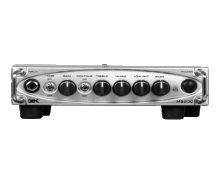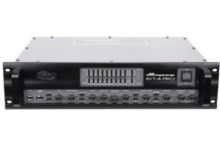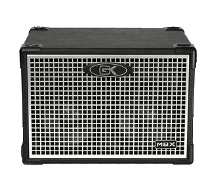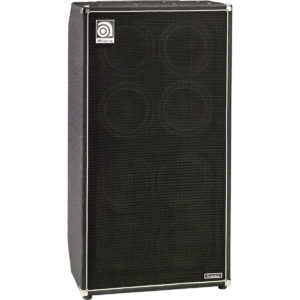The professional bass amplifier guide
Professional bass amplifier
Half and full stacks
If you’ve been playing a few years now you should seriously consider obtaining a professional bass amplifier. You will want to have a look at stacks also known as half stacks, full stacks, cabinets, or rigs. The main benefit of this set up / rig is the customisation, interchangeable equipment and the enormous output power available to them.
We use the term “stack” to describe the amplifier cabinets stacked on top of one another. A full stack would look like an 8X10 (or two 4X10’s stacked top of each other). A half stack, is just that. Half a full stack which is typically one 4X10 with an amplifier head on top. In this post when we refer to half stacks, we are discussing a cabinet with few speakers on its own.
With these rigs the budget has the potential to be in the top hundreds or low thousands but worth every penny in the long run of a serious professional bassist. Wattage can go from 200 watts at the minimum all the way up past 1000 watts.
Features of Bass Stacks
- Serious power of 1000+ Watts available
- Highly customisable and interchangeable
- Perfect in large venues and recording
- Works well without PA
- Versatile for all situations (Genres/shows)
Stacks large and small are intended for much larger and louder environments like rehearsals, recording sessions or live open air and indoor performances with or without the need of back-line amplification (PA system). They come in different combinations of sizes which makes your rig highly customisable and suited for every occasion. The drawback is that you will have to know what which parts are compatible depending on your needs.
Stacks are made of two components which will need to be put together, the two being amplifier heads and cabinets. Different to a combo amplifier as the components must usually be bought separately, checked for compatibility and linked together to operate. All the components have enormous variety and difference between the makes and models. Stacks are used by experienced bass players who either need more output or have a preference to a certain amp character and their features (analogue vales/ solid state digital etc.).
Making it easy – Bass Stack Packs come with a compatible Head Amplifier and Cabinet.
What are the separate components in a half/full stack?
Amplifier heads
The head of the bass is responsible for powering your cabinet – The power aspect (measured in wattage) can come in different models. Some heads may give you the option to attenuate the output power as a feature, which can be handy depending on the situation (playing café clubs, acoustic typed sets or larger) or you may find dedicated heads which only serve a specified output. This will come to personal preference and mostly dependant on your needs and how it affects your sound with your band mates, typically bassists are encouraged to buy as much wattage as possible early on as you can always turn down, but turning up would require a higher rated wattage.
What to look for in an amplifier head?
- Determine your wattage needed
- Do you need extra features (EQ/Routing/EFX)?
- Think about cabinet compatibility
The louder you play the higher your wattage rating will need to be; you don’t want to be under-powered and unheard. If you rely on a clean bass tone, driving a small amp harder will make it distort which may or may not be suitable in your performance and cause damage to the speaker.
The second purpose offers features such as dual or more channels – which gives you the opportunity to have different saved settings and changing them via a foot pedal. These channels are usually intended to be used for a drive effect (overdrive, distortion etc.) Other features include graphic equalisers to cut or boost certain frequencies, outbound routing possibilities such as effects loops and direct outputs or wattage selector switches. The list of options in heads goes on and on.
Cabinets
The cabinets are a wooden enclosure with speakers built into it. They can come in a variety of shapes and sizes depending on your needs. The type of wood used can have an effect on the resonance of the cabinet as well as the weight.
How many speakers to I need?
Cabinets are sold by the number of speakers they have. Small speakers come in lots of 2, 4, 6 and 8’s so for example four 10 inch speakers are listed as 4X10’s (4 by 10 inches) and larger speaker sizes are usually sold by themselves e.g. 1X15 or 1X18.
If your rig is going to be played at home a lot then it is suggested you have a rig with larger speakers by the likes of 1X12,1X15 or 1X18 inches. In this case the larger speakers will work better in a smaller environment with less contention for volume.
When playing live or with others it is advised to be using smaller speakers and more of them as this adds better tonal balance and keeps higher harmonic frequencies at higher volumes too. A popular arrangement is 2X10 or 4X10.
When buying a cabinet
- Choose the right cabinet size for your style
- Smaller speakers have more clarity
- Consider weight and portability
- Consider expansion / more cabinets
As a rule of thumb a bigger speaker will carry a better bass response producing lower frequencies (E.g. 1X15 or 1X18 inch speaker). Bigger isn’t necessary better these days as bass guitars do have harmonics that will be solely missed with a larger speaker.
Your first bass rig
Taking the advice from our Bass Amplifier Guide series we would recommend a small half stack.This home set up would cover practising solo, rehearsing with a group, recording and performing live without being too big or expensive for your needs at this stage. You also have the ability to upgrade and add additional cabinets if you grow out of it.
Power your cab with the Gallien Krueger MB200 200W Ultra Light Bass Amp Head and you have ridiculously light half stack with a great amount of power. An easy to dial EQ with a loud aggressive, punchy, tight tone that rivals similar amplifier heads.  The Gallien Krueger Neo amplifier 115 cabinet is small and durable with a superb balanced tone. It can handle a large output of up to 800 Watts without any issues. This makes it perfect for playing quiet or loud in most common performing situations.
The Gallien Krueger Neo amplifier 115 cabinet is small and durable with a superb balanced tone. It can handle a large output of up to 800 Watts without any issues. This makes it perfect for playing quiet or loud in most common performing situations.
The professional rig
The full stack is probably what comes to mind when we discuss amplifiers. A full stack is equipped to handle pretty much every performing situation you can muster. From venues big to small, the gear is totally adaptable and provides a solid quality tonal sound.
For the most part Rock, Metal and Punk music all benefit from the same type of amplifier set up. These genres are typically loud, fast paced and don’t really vary in dynamics. For that reason, the example below will provide ample power and take advantage of a smaller speaker size.
One of the most renown full stacks you will ever have the pleasure of hearing from Ampeg amplifers. These amplifiers are by and large the best bass amplifier you will come across.The preamp and driver in this amplifier runs on analogue valves. Providing your input with a true warm analogue signal that cannot be replicated in normal amplifiers.
The Ampeg SVT 4 Pro Bass Amp Head has an indescribable warm, punchy tone with plenty of ways to voice or enhance your preferred range. It has the ability to produce a humongous 1200 Watts and virtually every maintream musician uses it.
To compliment the SVT 4 amplifier most users combine it with an Ampeg SVT-810E (8X10) cabinet. This cabinet is the pinnacle of modern Rock, Punk and Metal music. Able to withstand the output of the 1200W head, it produces loud, thick and harmonic sounds. Built like a tank, it will last you a life time. If space is an issue you can always buy the 4X10 model and expand in the future.
Conclusion
This concludes our amplifier guide series and we hope it was informative. The table below will be the best way to decide at a glance how much wattage you need, how many speakers and their sizes and what situations you can take it to.
| Level | Primary use | Reccomended amplifier type | Wattage | Guide available |
|---|---|---|---|---|
| Beginner | Home practice, small rehearsals, very small performances. | Practice amplifier (1X6, 1X8) | 10-75 | Beginner guide |
| Beginner-Intermediate | Rehearsal space, performing with backline and recording | Combo amplifier (2X10, 1X12, 1X15) | 75-400 | Intermediate guide |
| Intermediate to Professional | Rehearsals, recording and performing with or without backline | Half/ full stack (4X10, 6X10, 8X10) | 400+ | Professional guide |
If you are still unsure, read up on the examples in these guides but if you really want to make it easy. Ready made Bass amplifier packs are available with everything you need to power your bass, straight out the box.


